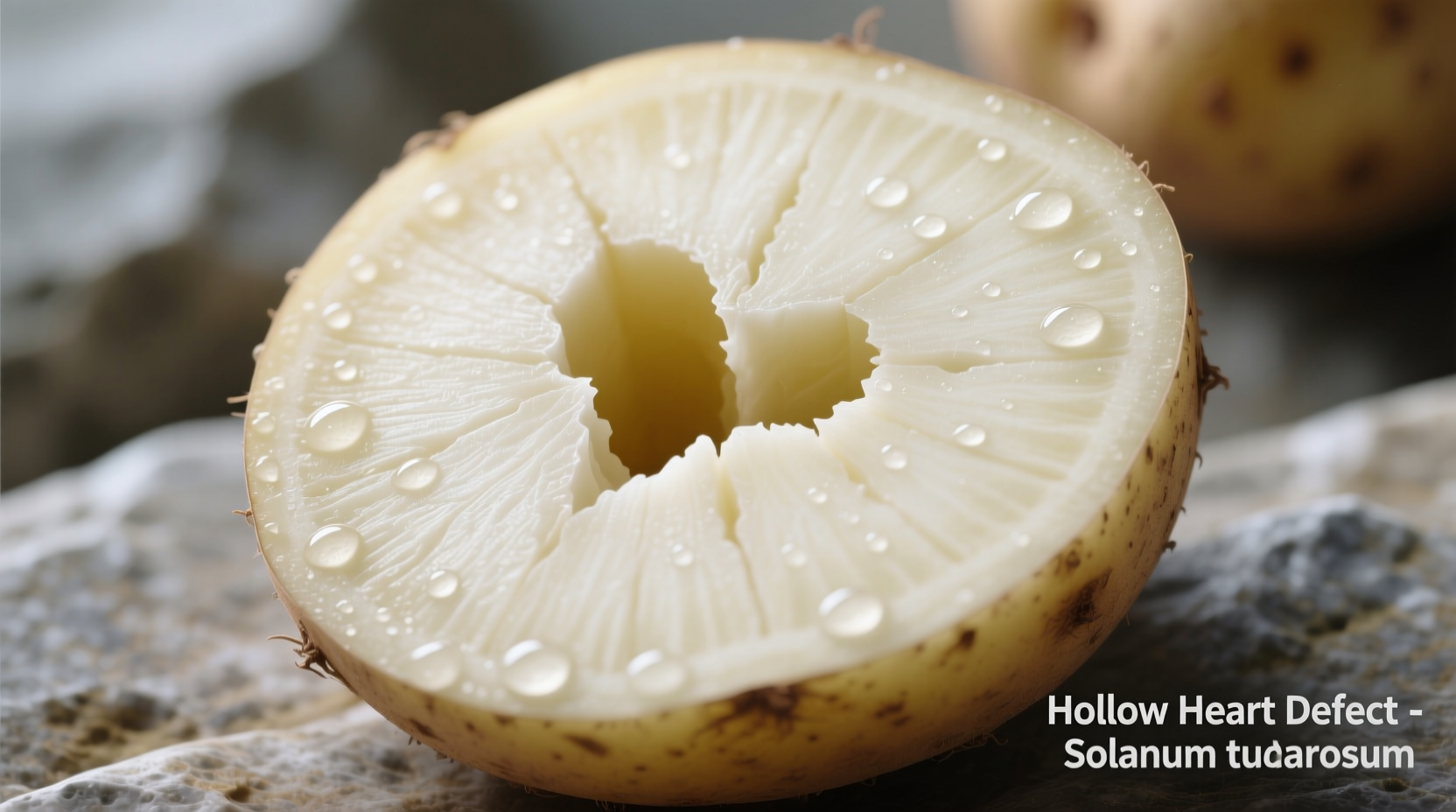Discover exactly what causes this common potato defect, how to identify it versus more serious issues, and practical steps to prevent hollow heart whether you're growing potatoes in your backyard garden or managing commercial crops. This guide delivers science-backed insights you can trust from agricultural research institutions worldwide.
What Exactly Is Hollow Heart in Potatoes?
Hollow heart appears as an irregular cavity in the center of a potato tuber, often star-shaped or oval. Unlike diseases caused by pathogens, this is a physiological disorder resulting from uneven growth patterns. The cavity forms when the potato's interior growth can't keep pace with the outer layers, creating a void as cells collapse.
University of Idaho's College of Agricultural and Life Sciences confirms hollow heart occurs when "rapid tuber development is followed by a sudden change in growing conditions" (uidaho.edu/cals/cnas). This non-infectious condition affects primarily the tuber's appearance without introducing harmful compounds.

Spotting Hollow Heart: Visual Identification Guide
When cutting through a potato, hollow heart reveals itself as an empty space in the center, sometimes accompanied by discoloration along the cavity walls. Key identification features include:
- Cavity shape: Typically star-shaped or oval
- Location: Centered within the tuber
- Wall appearance: Smooth, not rotten or decayed
- Discoloration: May show light brown or grayish tones
- Occurrence: More common in larger tubers
Hollow Heart vs. Other Potato Disorders: Critical Differences
| Condition | Appearance | Cause | Safety Concern |
|---|---|---|---|
| Hollow Heart | Empty cavity, smooth walls | Growth stress | Safe to eat |
| Brown Heart | Brown, necrotic tissue | Oxygen deficiency | Remove affected areas |
| Blackheart | Black, sunken decayed areas | Heat damage | Discard affected potatoes |
| Common Scab | Rough, corky surface lesions | Soil bacteria | Safe, peel affected areas |
This comparison, verified by Cornell University's Potato Variety Management Program (cals.cornell.edu/potato-research), helps distinguish hollow heart from more serious conditions requiring different handling.
What Causes Hollow Heart in Potatoes?
Three primary factors trigger hollow heart development:
1. Rapid Growth Followed by Sudden Stress
When potatoes experience ideal growing conditions (plenty of water and nutrients) followed by sudden environmental changes, the interior tissue can't maintain pace with outer growth. The University of Wisconsin-Madison Extension notes this commonly occurs after heavy rainfall following dry periods or sudden temperature drops.
2. Variety Susceptibility
Certain potato varieties show higher vulnerability to hollow heart. Research from the USDA Agricultural Research Service identifies Russet Burbank, Atlantic, and Shepody as particularly susceptible varieties. Choosing less vulnerable varieties like Kennebec or Yukon Gold can significantly reduce occurrence.
3. Nutrient Imbalance
Excessive nitrogen application, particularly late in the growing season, promotes rapid vegetative growth that outpaces tuber development. The Michigan State University Extension recommends maintaining balanced fertilization, with particular attention to potassium levels which help regulate water movement in plants (canr.msu.edu/topics/potatoes).
Is Hollow Heart Potato Safe to Eat? Your Practical Guide
Yes, hollow heart potatoes are completely safe for consumption. The cavity represents a physical defect rather than chemical contamination or pathogen presence. Simply follow these steps:
- Cut away the hollow portion and any discolored tissue
- Inspect for secondary issues like rot or mold
- Prepare as you normally would—the unaffected portions retain full nutritional value
Unlike conditions such as blackheart (caused by heat damage) or fusarium dry rot, hollow heart doesn't produce harmful compounds. The Food and Agriculture Organization of the United Nations confirms that physiological disorders like hollow heart "affect marketability but not food safety" (fao.org/3/y4358e/y4358e06.htm).
Preventing Hollow Heart: Actionable Strategies for Growers
Whether you're managing commercial fields or a backyard garden, these evidence-based approaches reduce hollow heart incidence:
Irrigation Management
Maintain consistent soil moisture levels throughout tuber bulking stage. Drip irrigation systems help avoid the moisture fluctuations that trigger hollow heart. The International Potato Center recommends keeping soil moisture at 60-80% field capacity during tuber development (cip.cgiar.org).
Variety Selection
Choose varieties with lower hollow heart susceptibility for your growing conditions. Consult your local agricultural extension office for region-specific recommendations—what works in arid climates may differ from humid regions.
Nutrient Balance
Avoid excessive nitrogen fertilization, particularly late in the season. Ensure adequate potassium levels which help regulate water movement in plants. Soil testing before planting helps establish proper nutrient balance.
Harvest Timing
Harvest when tubers have reached mature size but before they become oversized. Larger tubers show higher hollow heart incidence, so consider harvesting slightly earlier if conditions favor rapid growth.
When to Worry: Hollow Heart vs. Serious Potato Issues
While hollow heart itself isn't concerning, it can sometimes coincide with other issues. Be alert for these warning signs that indicate more serious problems:
- Soft, mushy texture around the cavity (indicates rot)
- Strong unpleasant odor (sign of bacterial infection)
- Extensive dark discoloration spreading beyond the cavity
- Mold growth inside or outside the cavity
If you observe these symptoms, discard the potato as it may harbor pathogens. Pure hollow heart shows only an empty space with possibly slight discoloration along smooth walls.
Commercial Implications of Hollow Heart
For commercial growers, hollow heart primarily affects marketability rather than safety. The condition makes potatoes unsuitable for certain processing applications and fresh market standards. However, affected potatoes can often be redirected to markets less concerned with appearance, such as:
- Dehydrated potato products
- Canned potato applications
- Animal feed operations
- Local farmers' markets where appearance matters less
Understanding these alternative markets helps minimize economic loss from hollow heart-affected crops.











 浙公网安备
33010002000092号
浙公网安备
33010002000092号 浙B2-20120091-4
浙B2-20120091-4